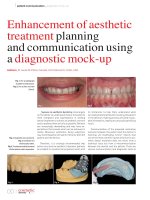QUALITY ASSURANCE OF TREATMENT PLANNING SYSTEMS
Bạn đang xem bản rút gọn của tài liệu. Xem và tải ngay bản đầy đủ của tài liệu tại đây (573.32 KB, 42 trang )
VIETNAM NATIONAL UNIVERSITY, HA NOI
VNU UNIVERSITY OF SCIENCE
FACULTY OF PHYSICS
----------
NGUYEN THI THANH
QUALITY ASSURANCE OF TREATMENT
PLANNING SYSTEMS
Submitted in partial fulfillment of the requirements for the degree of
Bachelor of Science in Physics
(Advanced Program)
Hanoi - 2017
VIETNAM NATIONAL UNIVERSITY, HA NOI
VNU UNIVERSITY OF SCIENCE
FACULTY OF PHYSICS
----------
NGUYEN THI THANH
QUALITY ASSURANCE OF TREATMENT
PLANNING SYSTEMS
Submitted in partial fulfillment of the requirements for the degree of Bachelor
of Science in Physics
(Advanced Program)
SUPERVISORS: CAO VAN CHINH, MSC
NGUYEN XUAN KU, MSC
Hanoi - 2017
ACKNOWLEDGEMENT
First of all, I would like to express my sincere gratitude to Master
Nguyen Xuan Ku, my research supervisor, for his dedicated guidance and the
tremendous mentor to me. His advices on my both research as well as my
future career is priceless that allowing me to grow as a research scientist.
I also sincere give my grateful to Master Cao Van Chinh, who has
appropriate comments for my thesis to be more completion.
Besides, I would like to thank all teachers, lecturers, researchers and
other seniors in Faculty of Physics, particularly Department of Nuclear
Technology, Vietnam National University, VNU University of Science, who
always create good opportunities for students to work and experience.
I would like to give thankfulness to my family and all my friends who
have supported and encouraged me in studying and researching. They have
become my motivation to get over the hard time.
Student,
Nguyen Thi Thanh
2
CONTENTS
CHAPTER 1: RADIATION THERAPY ........................................... 2
1.1.
The steps in treatment planning process ............................. 2
1.2.
The treatment planning process ........................................... 3
CHAPTER 2: QA FOR RPT SYSTEM ............................................. 5
2.1 Nondosimetric Commisioning.................................................. 5
2.1.1. Patient Positioning and Immobilization ............................. 5
2.1.2. Image Acquisition ................................................................. 7
2.1.3. Anatomical Description ..................................................... 9
2.1.3.1. Image conversion and input .............................................. 9
2.1.3.2. Anatomical structure: ...................................................... 10
2.1.3.3. Density representation. ................................................... 12
2.1.3.5. Image use and display. .................................................... 12
2.1.4. Beams ................................................................................. 13
2.1.4.1. Beam definition................................................................ 13
2.1.4.1. Description of machine, limits and readout. ................... 14
2.1.4.2. The accuracy of geometric: ............................................. 15
2.1.4.3. Field shape design: ......................................................... 15
2.1.4.4. Wedges: ........................................................................... 16
2.1.4.5. Beam and aperture display: ............................................ 17
2.1.5. Operational aspects of dose calculation ......................... 17
2.1.5.1. Methodology and algorithm use: .................................... 18
2.1.5.2. Density corrections: ........................................................ 19
2.1.6 Plan Evaluation.................................................................. 20
2.1.6.1. Dose display: ..................................................................... 20
2.1.6.2. Dose volume histograms: .................................................. 21
3
2.1.6.3 Use of NTCP/TCP and other tool: ................................... 21
2.1.6.4 Composite plans: .............................................................. 22
2.1.7. Plan Implementation and Verification. .......................... 22
2.1.7.1. Scale conventions ............................................................ 22
2.1.7.2 Data transfer: ................................................................... 23
2.1.7.2 Portal image verification: ................................................ 24
2.2 Dose calculation commissioning ............................................ 24
2.2.1 Measurement of self-consistent dataset ........................... 26
2.2.2 Data input into the RTP system ......................................... 28
2.2.2.1 General considerations. ................................................... 28
2.2.2.2 Transferring of data ......................................................... 28
2.2.2.3 Manual data entry ............................................................ 29
2.2.2.4 Inspection of input data .................................................... 30
2.2.3 Dose calculation algorithm parameter determination ... 30
2.2.4 External beam calculation verification ........................... 31
2.2.5 Brachytherapy calculation verification ........................... 32
Conclusion ............................................................................................ 33
4
2D
Two Dimensions
3D
Three Dimensions
BEV
Beam’s-eye-view
CT
Computerized Tomography
DVH
Dose Volume Histogram
MLC
Multi Leaf Collimators
MRI
Magnetic Resonance Imaging
NTCP
Normal Tissue Complication Probability
QA
Quality Assurance
RTP Systems
Radiation Treatment Planning System
TCP
Tumor Control Probability
5
LIST OF FIGURES
Figure 1: Patient head cast ...................................................................... 6
Figure 2 Tumor localization by laser ...................................................... 6
Figure 3 MLC ....................................................................................... 16
Figure 4: Regions for photon dose calculation agreement analysis ..... 31
LIST OF TABLES
Table 1: Imaging artifacts and their consequences ................................. 8
Table 2. Image input tests ..................................................................... 10
Table 3: Anatomical structure definitions ............................................ 10
Table 4: MLC parameters ..................................................................... 14
Table 5: Methodology and algorithm use ............................................. 19
Table 6: Dose display test ..................... Error! Bookmark not defined.
6
INTRODUCTION
In recent year, radiation therapy has become more and more popular
and important in cancer treatment. The sophistication and complexity of
clinical treatment planning and treatment planning systems has increased
significantly, particularly including three-dimensional (3D) treatment
planning systems, and the use of conformal treatment planning and delivery
techniques. This has led to the need for a comprehensive set of quality
assurance (QA) guidelines that can be applied to clinical treatment planning.
In order to successfully implement an appropriate quality assurance
program for treatment planning, adequate resources must be allocated. So
that, the most responsibility of radiation oncology physicist is afforded
adequate time to ascertain the extent and complexity of the treatment planning
needs of the radiation oncology clinic, and based upon this information, the
physicist must design and implement an appropriate quality assurance
program.
For this reason, I chose the “QA for treatment planning systems” as the
subject of my bachelor thesis.
This thesis includes two chapters:
Chapter 1: Radiation therapy
Chapter 2: QA for Clinical Radiotherapy Treatment Planning Systems
Page 1
CHAPTER 1: RADIATION THERAPY
The goal of radiation therapy treatment of cancer is accurate delivering
the prescribed dose to tumor area with high precision, while preserving the
surrounding healthy tissue.
The process of treatment planning, inasmuch as it determines the
detailed technique used for a patient's radiation treatment, is instrumental in
accomplishing that goal.
1.1.
The steps in treatment planning process
In actuality, treatment planning is a much broader process than just
performing dose calculations: it encompasses all of the steps involved in
planning a patient's treatment.
- The first step is positioning and immobilization patient. The patient
position has to maintain during treatment.
- The second step is determining the target volume (size, extent, and
location) of patient’s tumor, and its relationship with normal organs and
external surface anatomy. This step is performed with special
equipment such as MRI, CT scanners, CT simulator…[1]
- After completing first two process, the treatment planning process can
begin. This step is performed using a computerized radiation treatment
planning system (RTP systems). The RTP system is comprised of
computer software, at least one computer workstation which includes a
graphical display, input devices for entering patient and treatment
machine information, and output devices for obtaining hardcopy
printouts for patient treatment and records.
- The final step in treatment planning process, plan verification, involves
checking the accuracy of the planned treatment prior to treatment
delivery. During this step, the patient may return to the department for
additional procedures including a “plan verification” simulation or
“setup”. Additional radiographic images may be taken and treatment
information may be transferred from the planning system to other
computer systems (such as a record and verify system or treatment
Page 2
delivery system) so that the plan may be delivered to the patient by the
treatment machine. [1]
1.2.
The treatment planning process
Radiotherapy treatment planning (RTP) has long been an important and
necessary part of the radiotherapy treatment process. So that, to guarantee
treatment planning process is being performed correctly is thus an important
responsibility of the radiation oncology physicist. In recent years, as 3D and
image-based treatment planning has begun to be practiced in numerous
clinics, the need for a comprehensive program for treatment planning QA has
become even more distinct.
The radiotherapy treatment planning process is defined to be the
process used to determine the number, orientation, type, and characteristics of
the radiation beams (or brachytherapy sources) used to deliver a large dose of
radiation to a patient in order to control or cure a cancerous tumor or other
problem.
In treatment planning process, the physician uses a computerized
treatment planning system to define the target volume, determine beam
directions and shapes, calculate the associated dose distribution, and evaluate
that dose distribution. The RTP system includes a software package, its
hardware platform, and associated peripheral devices. Diagnostic tests
(imaging, x rays, other laboratory tests), clinical impressions, and other
information are also incorporated into the planning process, either
qualitatively or quantitatively (an example is the creation of a model of the
patient's anatomy based on information from CT scans). The treatment
planning process includes a wide spectrum of tasks, from an evaluation of the
need for imaging studies up to an analysis of the accuracy of daily treatments
The clinical treatment planning process:
Patient Positioning and Immobilization
- Establish patient reference marks/patient coordinate system.
Image Acquisition and Input
- Acquire and input CT, MR, and other imaging information into the
planning system.
Page 3
Anatomy Definition
- Define and display contours and surfaces for normal and critical
structures.
- Geometrically register all input data (CT, MR), including registration
with initial simulation contours, films, patient position, etc.
- Define target contours, generate 3-D target surface using surface
expansion, import target information from multiple imaging
modalities.
- Generate electron density representation from CT or from assigned
bulk density information.
Beam/Source Technique
-
Determine beam or source arrangements.
Generate beam's-eye-view displays.
Design field shape (blocks, MLC).
Determine beam modifiers (compensators, wedges).
Determine beam or source weighting.
Dose Calculations
- Select dose calculation algorithm and methodology, calculation grid
and window, etc.
- Perform dose calculations.
- Set relative and absolute dose normalizations.
- Input the dose prescription.
Plan Evaluation
-
Generate 2-D and 3-D dose displays.
Perform visual comparisons.
Use DVH analysis.
Calculate NTCP/TCP values, and analyze.
Use automated optimization tools.
Plan Implementation
- Align (register) the real patient with the plan (often performed at a
plan verification simulation).
- Calculate Monitor Units or implant duration.
- Generate hardcopy output.
- Transfer plan into record and verify system.
- Transfer plan to treatment machine.
Plan Review
- Perform overall review of all aspects of plan before implementation. [1]
Page 4
CHAPTER 2: QA FOR TREATMENT PLANNING SYSTEM
After the installation of a TPS in a hospital, acceptance testing and
commissioning of the system is required, i.e., a comprehensive series of
operational tests has to be performed before using the TPS for treating
patients. These tests, which should partly be performed by the vendor and
partly by the user, do not only serve to ensure the safe use of the system in a
specific clinic, but also help the user in appreciating the possibilities of the
system and understanding its limitations. In the past some irradiation
accidents happened with patients undergoing radiation therapy, which were
related to the misuse of a treatment planning system. Most often these
accidents were not the result of system malfunctioning but due to a lack of
understanding of how the TPS works. More details related to the incidence of
accidents in radiotherapy can be found in several reports (IAEA 2000, IAEA
2001, ICRP 2001, Cosset 2002). In many of these accidents, a single cause
could not be identified but usually there was a combination of factors
contributing to the occurrence of the accident. The most prominent factors
were deficiencies in education and training, and a lack of quality assurance
procedures. Good training, as well as the availability of well documented
quality assurance procedures, therefore have a huge impact in preventing
planning errors. [12]
2.1 Nondosimetric Commisioning
2.1.1. Patient Positioning and Immobilization
Patient positioning and immobilization are said to be the most crucial
part of radiotherapy treatment. Many planning decisions are based on data
from these procedures.
- Immobilization: help the patient remain motionless during treatment.
Immobilization techniques may be as simple as positioning the arms in
a particular fashion or as complicated as the use of an invasive
stereotactic device. The quality of the immobilization affects the
reproducibility with which the patient is positioned for each of the
procedures involved in the planning/delivery process, and may affect
Page 5
the accuracy of treatments. The use of particular immobilization
devices may change image quality and/or monitor unit calculations, so
these effects should be investigated prior to clinical use. Note that few
immobilization devices actually keep the patient immobile, so motion
and positioning errors often continue to be a concern even with use of
such a device.
Figure 1: Patient head cast [19]
Figure 2 Tumor localization by laser[20]
- Positioning and simulation. The next step in the planning process
involves localizing the volume to be treated. This includes defining the
Page 6
positions of the patient, tumor, target, and normal structures.
Traditionally, this procedure has been accomplished with the simulator
using orthogonal radiographs, a manual contour, and laser marks which
establish an initial isocenter.
However, with the development of image-based RTP systems and
“virtual” simulation, localization procedures involving CT images are now
often used.
No matter how it is obtained, the patient position information must be
acquired accurately and then transferred accurately into the RTP system for
further planning and analysis. Similar accuracy requirements hold for beam
geometry and other information obtained during simulation. Simulators, CT
scanners, and “virtual” simulators should therefore be subject to a rigorous
QA program that includes both mechanical and image quality tests. For
example, for simulators and CT/MR scanners, the geometrical accuracy of all
beam and couch parameters, laser alignment systems, and gradicules should
be assessed. [2, 3, 4]
2.1.2. Image Acquisition
The images used to define patient anatomy obtained from many source:
CT, MRI. PET, SPECT. The manner in which these imaging data are acquired
may have dramatic effects later in the planning process, particularly if the
data are not acquired correctly. QA of image acquisition must ensure that
images have been obtained in an optimal way, and that their transfer into the
RTP system, and use therein, has been performed accurately.
Imaging parameters. Numerous imaging system parameters can affect how
the image data are used. For example, incorrect setting or reading of image
parameters such as pixel size, slice thickness, CT number scale, and
orientation coding can cause the RTP system to make incorrect use of the
data. Furthermore, lack of understanding of partial volume effects in crosssectional images may cause incorrect identification of anatomical or other
information from the images. Control of the imaging parameters at acquisition
is therefore an important part of the QA process that applies to each patient.
Page 7
- the extent of the patient that is to be scanned,
- the position of the patient as well as any immobilization devices,
- location and type of radio-opaque markers used on patient surface as
coordinate system reference,
- scan parameters such as slice spacing and thickness,
- breathing instructions for patients scanned in abdomen and/or chest,
- the policy on the use of contrast agents (for CT, MR, and other
modalities).[1]
Artifacts and distortion in image acquisition systems. All imaging systems
are susceptible to artifacts and/or geometrical distortions, thus information
from the image may need to be modified or interpreted before it can be
used.
Table 1: Imaging artifacts and their consequences
Artifact
Consequence
Finite voxel size
Errors in delineation of target
volumes and structure outlines,
particularly for small targets
and/or thick slices.
Partial volume effects
Errors in voxel grayscale values
and in contours obtained via
autocontouring
High-density heterogeneities
Streaking artifacts in CT
images, which can lead to nonrepresentative density values
and image information.
Contrast agents
Errors in voxel grayscale values.
May lead to errors in CTderived electron densities or
interpretation
of
imaging
information for other modalities.
MR distortion
Distortion in geometric accuracy
of MR images, dependent
typically on magnetic field
homogeneity,
changes
in
magnetic
susceptibility
at
interfaces, and other effects.
Page 8
May
lead
to
incorrect
geometrical
positioning
of
imaging information.
Paramagnetic sources
Local distortions in MR images
2.1.3. Anatomical Description
The anatomical model or description of the patient is one of the most
critical issues in RTP. We don’t have the good dose distribution unless we
have correctly identified the tumor, target or normal tissues. Therefore, a
significant effort should be spent on QA of the anatomical description. [1]
2.1.3.1.
Image conversion and input
Image acquisition for treatment planning is usually performed by
computed tomography (CT) and magnetic resonance imaging (MRI). In
special cases, positron emission tomography (PET) and single photon
emission computed tomography (SPECT) are additionally used. Each imaging
modality is applied for specific reasons: the CT dataset may be mapped to the
electron density of the tissue and is needed to calculate dose distribution
within the patient. MRI, on the other hand, provides superior soft tissue
contrast and is used to delineate the tumour and the organs at risk. PET and
SPECT images can be used additionally to measure the relative metabolic
activity for detecting differences in tumour regions or differentiating tumour
from necrosis. These complementary aspects can be integrated into treatment
planning by correlation of the images from different modalities.
As an essential prerequisite for the treatment planning process and, in
particular for the correlation process, the images that are converted into the
TPS must reflect the real geometry of the patient, i.e., possible distortions of
the images have to be minimized. In addition, the accuracy of the correlation
also depends on the correct functioning of the multi-modality registration
software included in the treatment planning program such as image fusion
(co-registration). Therefore, appropriate tests are indispensable prior to the
first application to patients.
Page 9
Table 2. Image input tests
Topic
Tests
Reasons
Image geometry
Document
and
verify
parameters used to determine
geometric description of
each
image (number of
pixels, pixel size)
Vendor and scanner-specific
file formats and conventions
can cause very specific
geometrical errors when
converted for RTP system
Geometric
location and
orientation of
the scan
Document
and
verify
parameters used to determine
geometric location of each
image, particularly left-right
and head-foot orientations.
Vendor and scanner-specific
file formats and conventions
can cause very specific
geometrical errors when
converted for RTP system
Text
information
Verify
that
all
text Incorrect name or scan
information
is
correctly sequence identification could
transferred.
cause
misuse
or
misinterpretation of the scans
Imaging data
Verify accuracy of grayscale
values,
particularly
for
conversion of CT number to
electron density
Image
unwarping
(removing
distortions)
Test all features, including Methodologies which modify
the documentation tools imaging information may
which assure that the original leave incorrect data in place
and modified images are
correctly identified within the
system.
Wrong grayscale data may
cause incorrect identification
of anatomy or incorrect
density corrections
2.1.3.2. Anatomical structure:
The basic contours of the 2D system have been superseded by a
hierarchy of objects including points, contours, slices, 3D structures, 3D
surface descriptions, and even multiple datasets of self-consistent volumetric
descriptions. [1]
Table 3: Anatomical structure definitions
Term
Description
3-D anatomical A 3-D construct that delineates an anatomical
structure
object based on voxel, surface, slice, contour,
and/or other descriptions.
Page 10
Voxel
description
A set of 3-D voxels used to describe a particular
3-D structure.
Surface
description
A surface mesh that defines the boundary of a 3-D
structure
Slices
2-D planes, usually corresponding to 2-D images
Contours
2-D outlines, usually created on a slice or image
plane. These outlines are typically used to
generate the 3-D anatomical structure description
Reference lines
Straight or curved line segments used to mark
special anatomy or other features relevant to the
treatment plan.
Points
Points defined in 3-D, often used as markers.
Density
description
A description of the electron density of a
structure. Either defined as a bulk (or assigned)
value or derived from CT data.
Region-ofinterest
(ROI)description
A voxel or surface description of each 3-D
structure of interest. Used for calculation of dose
volume histograms and other kinds of statistics
Dataset
A geometrically self-consistent set of data (e.g., a
set of CT scans obtained in one acquisition)
3D Structures: the major differences between 2D and 3D RTP systems
is the description of anatomical structures. In 2D, most structures are defined
by 2D contours on one or a few axial slices, and contours are generally not
related from one slice to the next. In 3D, a 3D structure is created for each
anatomical object. This structure is often defined by a series of contours
drawn on multiple slices of some image dataset (for example, CT), and the
contours for a particular structure are all related. A 3D RTP system may
require many different procedures to check the 3D anatomical structure
description functionality.
Contours: Anatomical structures can be entered into the RTP system by
various methods, but the most typical method is to create contours on a series
of slices through the patient, and then to create the 3D structure from the
serial contours.
Page 11
Points and lines: The display and geometrical definition of points and
lines defined inside the system must accurately reflect the geometrical
location of the image on which they are defined. If multiple datasets are
allowed, then the point and line definitions must be checked in all image sets
and coordinate systems.
2.1.3.3. Density representation.
In most image-based planning systems, the CT data are used not only
for positional information about the anatomy, but also to define the relative
electron density (number of electrons per unit volume) distribution throughout
the patient model. This information is used for density-corrected dose
calculations. [1]
2.1.3.4. Bolus and editing the 3D density distribution
Bolus may be used in treatment planning in at least three different
ways:
- Definition of external bolus on the surface of the patient.
- Modification of the CT-based electron densities in a certain region of
the patient (e.g., to edit out the effects of contrast material).
- Introduction of bolus material into sinuses or other body cavities. [1]
2.1.3.5. Image use and display.
The various ways image information is used and displayed should be
considered in the RTP QA program.
2.1.3.6. Dataset registration.
One of the more powerful advances associated with the use of 3D
planning has been the ability to quantitatively use imaging information from
various different imaging modalities such as CT, MR, PET, SPECT,
ultrasound, and radiographic imaging. In order to use this information, the
planning system must contain tools which make it possible to quantitatively
register the data from one imaging modality with similar data obtained from
another modality. Checks of the dataset registration and multiple dataset
functionality involve general commissioning tests as well as development of
routine procedural checks to make sure the information is used correctly for
each particular case. [1]
Page 12
2.1.4. Beams
Beam definition and its use are critical items for the accurate design of
a treatment planning. A set of performance tests related to beam definition,
beam display and beam geometry are proposed. The vendor of the TPS should
do the majority of this set of tests during the acceptance-testing phase. Some
of these tests depend on how carefully the customization process was
performed. This is the direct responsibility of the medical physicist in charge
of the TPS, whether the customization is done by him (her) self or by the
vendor.
2.1.4.1. Beam definition
It is essential to understand, document, and test the behavior of all
beam parameters as beams are created, edited, saved, and used throughout the
planning process. [1]
Some of the parameters required to create the specification of a beam:
- Beam description
· Machine
· Modality
· Energy
- Beam geometry
· isocenter location and table position
· gantry angle
· table angle
· collimator angle
- Field Definition
· source-collimator distance
· source-tray distance
· source-MLC distance
· collimator settings (symmetric or asymmetric)
· aperture definition, block shape, MLC settings
· applicators
· skin collimation
- Wedges
· name
· type(physical, dynamic, auto)
· angle
· field size limitations
· orientations
Page 13
· accessory limitations (blocks, MLC, etc.)
- Beam Modifiers
· photon compensators
· photon and/or electron bolus
· various types of intensity modulation
- Normalizations
· beam weight or dose at beam normalization point
· plan normalization
Some parameters of MLC affect the RTP systems are listed in table 3
Table 4: MLC parameters
Leaf width
Leaf travel (min, max), field
size min and max.
Number of leaves
Overlap between leaves (the
tongue and groove design of
most MLC systems affect this
parameter)
Distance over midline that can
be traveled by a leaf
Maximum extension between
leaves.
Movement of the leaf carriage
Interdigitation
of
leaves
allowed or disallowed.
Leaf transmission
Leaf readout resolution.
Minimum
gap
opposing leaves
between
Jaw algorithm (how the jaw
positions are required to relate
to the MLC shape).
Leaf labels
Leaf end design
versus focused).
Leaf editing capabilities
Design of side of leaves.
Dynamic
leaf
(DMLC) capability
Leaf
synchronization
DLMC
motion
(curved
for
2.1.4.1. Description of machine, limits and readout.
As modern planning systems use more and more of the capabilities of
the treatment machine, an increasingly sophisticated description of the limits
of those capabilities for each particular machine must be a part of the beam
technique module of the planning system. Complex systems may make use of:
· numerous energies/modalities and specialized modes,
Page 14
·
·
·
·
individual jaw and MLC leaf motion limits,
number, type, and orientation of wedges,
naming conventions,
machine angle conventions, limitations, and resolution of readouts for
each motion,
· speed of motions, if available,
· the entire geometric shape of the treatment machine.[ 1, 5]
2.1.4.2. The accuracy of geometric:
The location and orientation of each beam in a plan must correspond to
the real situation. The correctness of the translation of the planning system
beam coordinates into those coordinates used to setup the fields on the actual
patient must be continuously monitored, since it depends not only on software
but on the treatment planning and treatment delivery procedures used in the
clinic. The geometric checks of accuracy include:
· The geometric resolution and accuracy for each parameter must be
assessed using the coordinate values contained inside the file which
contains the beam description as well as with graphical displays of the
information inside the RTP system.
· Complex combinations of motions should be entered and displayed to
verify the correct interactions between parameters. [1]
2.1.4.3. Field shape design:
Field apertures can be created using rectangular collimators, shaped
focused blocks, irregularly shaped electron cutouts, and MLC, and can be
entered into a RTP system using several different method. All methods of
field shape entry should be check.
- Manual aperture entry:
Field shape can be manually entered in some ways such as digitizing
block shapes drawn on simulator films, drawing with the mouse on a BEV
display or using keyboard or mouse to move the leaves of a MLC. [1, 6]
- Automatic aperture definition:
Automatic shape creation algorithms are often used to design block and
MLC shapes. A more complex testing procedure may be necessary for this
function, since these algorithms often include use of 3D projections of the
selected 3D surface onto the BEV plane, followed by an automatic routine
Page 15
which generates the correct aperture shape. These algorithms can be sensitive
to details of the anatomical or beam aperture representations, and should be
carefully checked over a series of different situations. [7, 8, 9]
- Special MLC features:
The exact correspondence of the MLC leaf position with the desired
and recorded positions must be verified. Also, the different methods used to
fit the leaves to a drawn aperture must be individually tested with aperture
shapes that will show deviations from the expected result if the algorithm
does not work correctly. Testing should include cases involving variable
margins, convoluted shapes, and the exclusion of normal anatomic structures
from the aperture. [1]
Figure 3: MLC [21]
2.1.4.4. Wedges:
It is an important component to use wedges in most treatment planning
and delivery.
There are some general concern for QA of wedges:
- Orientation and angle specification: Confirm that wedge orientation
and angle specifications are consistent the planning system, including
the hardcopy output.
Page 16
- 2-D display: Check display of wedges in different 2-D planes (parallel,
orthogonal, oblique) for different beam directions, collimator rotations,
and wedge orientations.
- 3-D display: Check display of wedges in room view 3-D displays for
situations as described above.
- Autowedges (wedges inside the head of the machine): confirm that the
division of a field into fractional open and wedged fields agrees in RTP
system and on the treatment machine.
- Dynamic wedge: verify that the implementation in the RTP system has
the same capabilities, limitations, orientations, and naming conventions
as on the treatment machine. [11]
2.1.4.5. Beam and aperture display:
Various types of displays and anatomical representations are used in
3D planning systems to aid the treatment planner in designing and evaluating
a beam configuration. Checks of the beam-anatomy projections can be based
on calculations of how various anatomical objects should be projected, or they
can be confirmed with film and the radio-therapy simulator using a phantom.
The calculation approach should be used at least once to confirm the accuracy
of the system.
2.1.4.6. Compensator:
Compensators can be designed either within the RTP system or by
some independent system. In either case, the accuracy of the input of
compensator in-formation such as size, shape, thickness variation, and
associated beam must be confirmed. Display and specification of
compensators can be checked much like that for wedges, blocks, and other
beam modifiers. Automated transmission of compensator information to a
compensator maker must also be checked. [1]
2.1.5. Operational aspects of dose calculation
The dose calculation is considered as the heart of the treatment
planning system. QA of dose calculations includes more than confirming that
the algorithm works correctly or that the calculated doses agree with the
measured ones. Many parameters must be defined before calculations can be
Page 17
performed, either explicitly by the user or by default by the system, and these
parameters influence the resulting dose distributions. [1]
The scope of checks of the operational aspects of the calculation
methodology which are required can be quite dependent on the sophistication
of the RTP system implementation. However, even if not all of the details
below are handled explicitly by the RTP system, each institution should
consider the relevance of each issue, since somewhere within the planning
process most of these issues are being handled, either explicitly or
implicitly.[1]
2.1.5.1. Methodology and algorithm use:
Page 18









